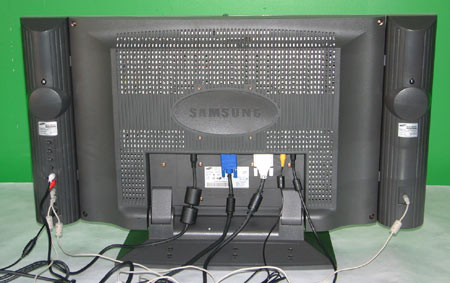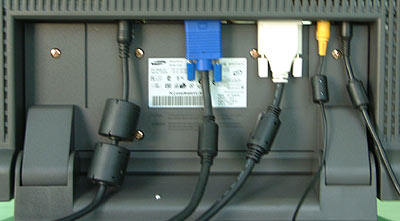The 240T comes with nearly 10lbs of wires, power bars
and bits of kit. The main power supply for the display is gigantic and can get
quite hot (maybe 30-40 degrees Celsius) after a few hours of continuous use. You
can see it in the left hand picture here, and does look kind of silly with those
four huge ferrite coils around the DC power cable.
Of course once all these wires are attached it gets to
be a bit of a rats nest back there, and the speakers are probably the worst of it. On
a side note, the 240T creates about as much heat as a 19" CRT because of the
large back light.

Analog / DVI Connectors
LCD displays are on the cusp of a
big swing in the way we connect our computers to monitors. With the launch of
the Geforce 4 things have only accelerated, and now it is rare to find
a video card without at least one DVI connector.
From the videocard level DVI can be adapted to analog,
but not the other way around. Since the specs for the Samsung
240T list the maximum supported resolution under DVI 1280x1024 it seems this display is better suited
for use with the analog connector. In reality we were able to work with 160x1200
@16bit color - so I'm not sure if this is a mistake or if
we were just running the display out of spec.
| Inputs and Outputs |
 |
The basic differences between the analog display adapter
and the DVI (digital) display adapter in case you don't know is how the
image is transmitted to the monitor. In the first instance, the analog version,
the image is sent to the monitor as waveform (essentially). Since we're
all accustomed to using CRT displays which operate on analog principles
this was the perfect match.
However, when these same analog signals
are sent to an LCD display - a device which only
operates on digital signals - the picture much be digitally encoded before it can
be processed and displayed. On the other hand, if you happen to be equipped with a
digital output on your video card, the digital signals are simply sent right to
the display to be shown on the screen.
While we couldn't detect any perceivable differences between
the two types of video hook ups in terms of display quality (both were excellent)
there are a few operational differences. An analog signal can be adjusted and tweaked to perfection,
but a digital signal comes to the display perfectly. For example, just try to
hit the auto adjust key while using the DVI connection.
